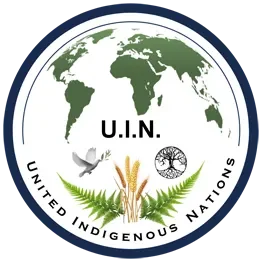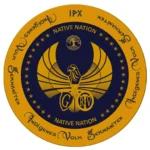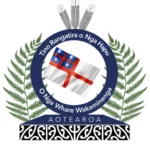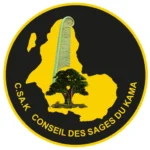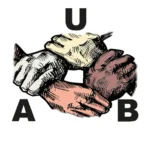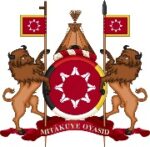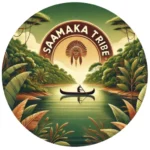More About Us
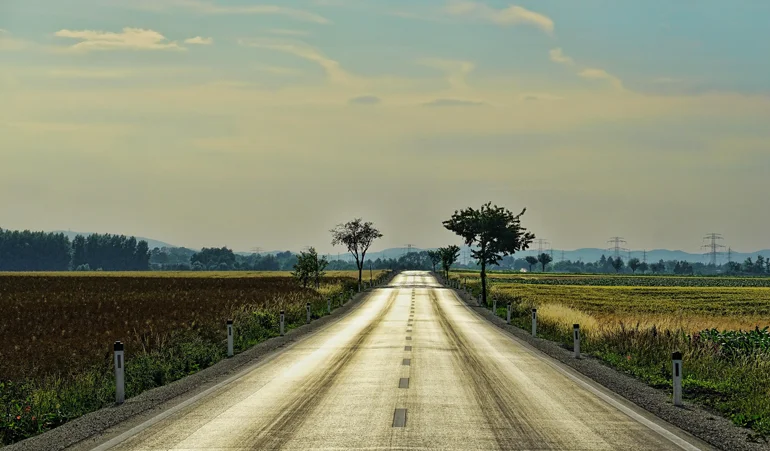
Our goals
- Every member of the U.I.N. is enabled to live a free and self-determined life in peace. *
- The enforcement of indigenous land, space and resource rights on the native territory of U.I.N. members. *
- Ensuring participation in resources and/or the associated yields on the native territory of the members of the U.I.N. *
- Every member of the U.I.N. is protected from criminalization, discrimination and violence. *
- All members of the U.I.N. are offered the opportunity to network and support each other.
* (in accordance with UNDRIP, ILO169, ICERD, UNCRC, FPIC and CAT)

Vision
The United Indigenous Nation (U.I.N.) is the global representative body of Indigenous nations and tribal alliances, dedicated to promoting the rights, cultures, and territories of Indigenous peoples and ensuring their protection.
It envisions a world in which Indigenous nations and tribal alliances are equal partners, empowered to make their own decisions and preserve their cultural identity for future generations.

Our Mission
The United Indigenous Nations (U.I.N.) sees itself as an international community united by shared values. Our mission is to strengthen mutual understanding and respect among peoples.
At the heart of our work is the possibility and right to self-determination – the fundamental right of every people to decide for themselves and to speak and act in their own name. This claim to autonomy and participation is not a privilege, but an essential characteristic of indigenous freedom.
Many indigenous communities who join us share the experience of being denied the exercise of their indigenous rights for years. In many cases, they lack access to the resources necessary for self-determined development. This lack is not accidental—it is the result of systematic disregard, often accompanied by discrimination, structural violence, and attempts to displace traditional ways of life.
The U.I.N. offers these communities a platform for encounter and cooperation. It is not about a particular ideology or political orientation, but rather about enabling self-responsibility in the spirit of peace and understanding.
Throughout all of this, the U.I.N. maintains its character as a supportive force: not as an authority imposed from above, but as a network of communities bound by shared values. Our mission is to establish and strengthen connections between peoples and tribal groups—and to give space to those voices that have been ignored for far too long.
Joining the U.I.N. : A Global Alliance of Indigenous Communities
After the U.I.N. was founded in 2024 by the Indigenous Germanite people and the Wakaminenga Maori government of Aotearoa Nu Tireni, the Republic of Lakota Nations, the Kinakwii, and the Union Autochtone Batwa joined.
The starting point for the accessions were the previously concluded peace agreements between the Germanite Indigenous People and the designated indigenous peoples and tribal associations.
The members commit themselves to a global dialogue for peace, justice, and cultural diversity within the U.I.N.
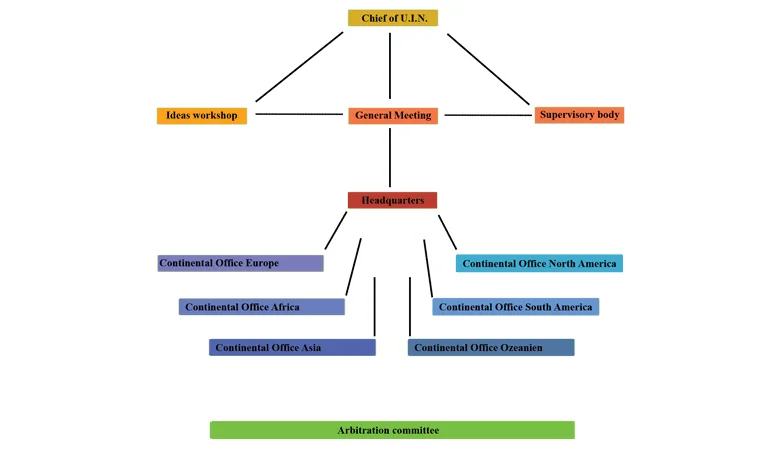
The Structure of the U.I.N.
The U.I.N. Agreement forms the foundation of the organization. It defines the core principles and objectives that guide the orientation and actions of the United Indigenous Nations. By signing the agreement, members commit themselves to actively implementing these principles.
The Chiefs of the U.I.N. are the highest representative authority and the external voice of the U.I.N. In fulfilling their duties, they act in accordance with the goals and guidelines of the U.I.N..
The General Assembly provides a platform for all members to exchange and discuss their perspectives on various issues. It approves the financial budget, appoints members to various bodies, issues recommendations, and serves as the highest decision-making body of the U.I.N.
The Innovation Forum of the U.I.N. develops new programs, strategic goals, and designs concepts for their implementation.
The Supervisory Council is responsible for ensuring compliance with the resolutions, guidelines, projects, and decisions of the U.I.N..
It serves as the organization’s main oversight body.
The Headquarters is the central hub — the operational heart of the U.I.N.. It is responsible for implementing decisions, ideas, and strategies. The headquarters houses, for example, the diplomatic service, administration, and the Indigenous judicial authority.
The Continental Offices serve as points of contact for all matters concerning their respective continents and act as interfaces between local affairs and the headquarters.
The Mediation Committee is the main judicial body of the U.I.N.. — an Indigenous court of justice.
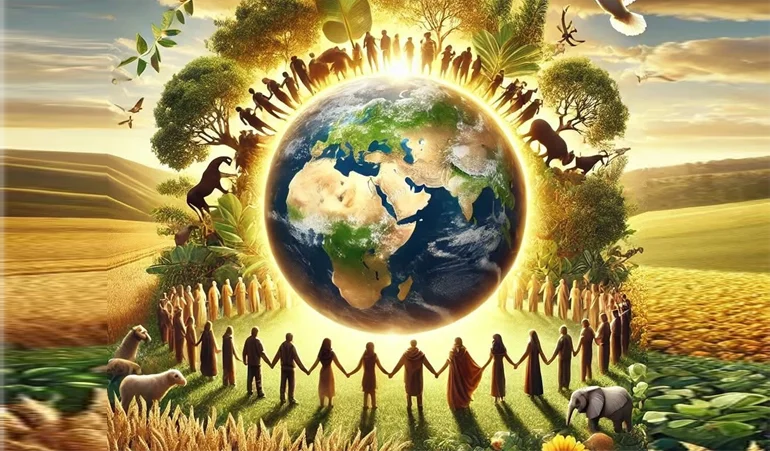
Worldwide United Indigenous Nation communities
Strategic planning of the 12 levels of society on 7 continents to connect the experts worldwide and encourage them to act together (DO).
Together for an indigenous
self-sufficient and sustainable divine way of life on Mother Earth
Worldwide indigenous future
Mother Earth - Creator
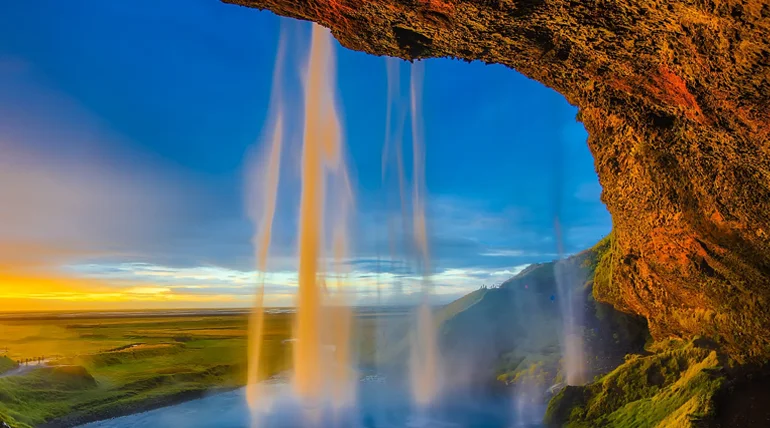
Mother Earth and Creator, Spirit, (space, sky)
- Spirituality & Nature – The city is based on respect for Mother Earth, spiritual traditions and sacred places.
- Rule of Soil, Territory of the Indigenous People, the Vatican also confirms that the allodial rights and the Rule of Soil are in the hands of the indigenous peoples and their relatives.
- For this reason, indigenous peoples have been deliberately mixed with allochthonous immigrants for thousands of years and then set against each other. Worldwide disunity and the resulting conflicts are the goal.
- Size: 2-10 hectares of land per family, depending on the intensity of farming.
- Location: Access to natural water, fertile soil and sunlight, sufficient forest areas
- Zoning: Residential houses, agricultural areas, energy production, communal areas.
- Communities and cities are designed according to principles of respect for nature and spiritual traditions.
- Sacred places and community spaces for ceremonies, meditation and spiritual practices.
- Sustainable architecture with natural materials that blend into the landscape.
- Spiritual education and rituals become an integral part of community life.
- Regular gatherings to honor the cycles of nature and the seasons.
Would you like to read more about it? Contact us!
Government - Justice - Authorities

Government, Justice, Authorities
- Government & Justice – A council of elders governs the city, with a focus on consensus, arbitration and participation.
- Establishment of a global Indigenous Court that is not horizontal but vertical across the 7 continents, aligned with Mother Earth (Rule of Soil) and the Creator.
- The THING (7), Council of Elders, Council of Ethics
- Continental Indigenous Court Systems
- Regional Indigenous Court Systems
- Based on the principle of agreement and arbitration
- A council of elders and representatives of all communities democratically decides on the city administration.
- Traditional indigenous jurisprudence combined with modern legal structures for conflict resolution.
- Open government processes with direct participation of the people.
- Principles of agreement and mediation are at the forefront of conflicts.
- Decentralized decision-making structures for equal participation.
Would you like to read more about it? Contact us!
Family - Purpurse - Education & Science

Family, Purpurse, education and science
- Family & Education – Holistic learning combines indigenous knowledge with modern science and intergenerational education.
- Each incarnation of a Creator into a timeline has a chosen mother and father.
- The incarnation serves to follow his calling according to the timeline.
- Kindergarten, school and universities are aligned with this truth.
- Dull, systemic, repetitive work can be taken over by AI and robots, art, music, architecture, caring for Mother Earth, free sovereign life is for the indigenous human.
- Community learning: schools and workshops for practical skills in agriculture, technology and crafts.
- Books and media: building libraries and digital platforms for knowledge exchange.
- Science serves the indigenous person, the truth-finding regarding Mother Earth, the Creator, the individual person in developing his/her perfect purpose in his/her incarnate timeline to heal the past (ancestors) and lay a foundation for the future (children and descendants) through his/her lifetime.
- Education system that integrates both indigenous knowledge and modern science.
- Schools with practice-oriented curricula and intergenerational learning.
- Vocational and technical training for a self-sustaining community.
- Family centers to support parents and children in educational issues.
- Intergenerational education programs for the exchange between older and younger generations.
Would you like to read more about it? Contact us!
Technology & Energy

Technology, tools and energy supply
- Technology & Energy – Sustainable, renewable energy and ecological technologies for a self-sufficient community.
- Space energy
- Energy from the ether
- Free energy
- Hydrogen
- magnetic motors
- Renewable energies: solar cells, wind turbines, biogas plants, small hydroelectric power stations.
- Storage options: Battery systems or other energy storage technologies.
- Efficient appliances: Use of energy-efficient technologies and appliances.
- Self-sufficient energy supply through decentralized solutions.
- Development of technologies in line with ecological principles.
- Promotion of research into indigenous techniques for the sustainable use of resources.
- Workshops for community crafts and technical innovation.
Would you like to read more about it? Contact us!
Nature’s Symphony
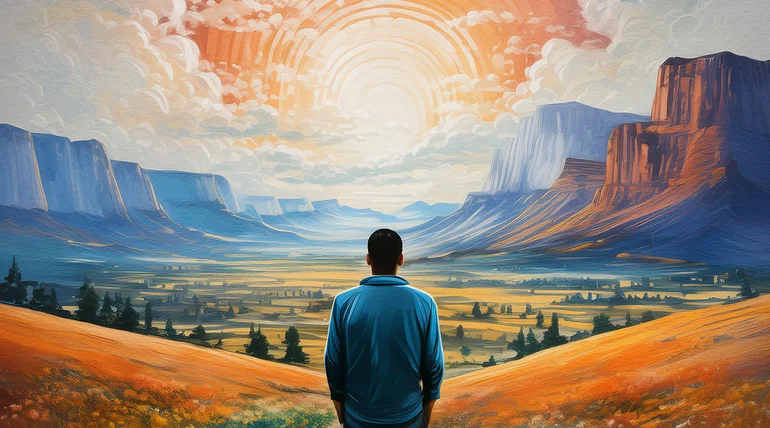
Water, mountains, forests, fields, meadows
- Nature & Water – Protection of biodiversity, sustainable land use and water management to preserve the environment..
- Water is the information carrier of all time and all previous events. Water is a healing element and the basis of all life. Water not only serves to quench our thirst, but can also heal or heal every cell of the body.
- Drinking water: Use of natural processes for regeneration and information Production of hexagonal water, use of wells, rainwater collectors and filter systems.
- Water from the room (air)
- Irrigation: Efficient irrigation systems such as drip irrigation.
- Wastewater: Natural wastewater treatment systems (Hacheney water systems) such as constructed wetlands and composting toilets.
- In deserts, water production from the air
- Repair of the climate through Desert Green or NHS stations.
- Protected areas for nature and biodiversity.
- Sustainable land use and agroforestry systems.
- Water management through rainwater harvesting and natural filtering methods.
- Use of traditional farming methods to preserve soil fertility.
- Sacred forests and natural sites are actively protected and maintained.
Would you like to read more about it? Contact us!
Health - Physical & Mental

Health and healthcare systems
- Healthcare system – Combination of traditional healing and modern medicine with prevention and naturopathy.
- Disharmony = results in negative DIS-stress
- Euphoria = results in positive EU-stress
- Deeply rooted connection to Mother Earth, the power of the connection to God the Creator, the power of divinely informed water, the power of divine grateful thoughts and imagination, the power of words spoken in divine energy,
- healthy sustainable in divine energy with Mother Earth and divine water and food planted on healthy Mother Earth
- Healthy oceans, lakes, rivers and air form the basis for a healthy human milleu. All food is restored to its divine original state (healthy original seeds, animals).
- Truth-based social 12 levels serve as the basis for a divine society so that people do not live in fear of existence and survival, fear of disease, war, theft, envy and stress in all areas of life.
- Indigenous health is based on healthy food with essential vitamins and minerals.
- Healing divine rituals performed by re-cultivating the knowledge of ancient traditions of druids and shamans who teach and provide their divine connection and skills to their village and society.
- Integration of traditional healing methods with modern medicine.
- Health centers with a focus on prevention and naturopathy. Community-based health care with herbal and plant medicine.
- Regular health workshops and spiritual healing rituals.
- Promotion of an active lifestyle through exercise and connection to nature.
Would you like to read more about it? Contact us!
Food Production
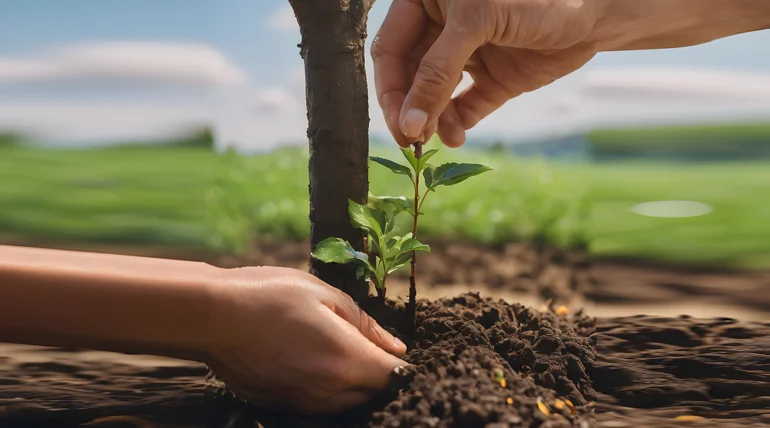
Food production, animal husbandry and plants
- Food & Agriculture – Organic farming, permaculture and ethical animal husbandry to ensure food security.
- Crop cultivation: Organic cultivation of fruit, vegetables, cereals and pulses.
- Animal husbandry: Livestock such as chickens, goats, sheep and aquaculture.
- Permaculture: Use of natural ecosystems for sustainable cultivation.
- Storage: Cold storage, fermentation and preserving for food preservation.
- Use of renewable energies such as solar, wind and water power.
- Self-sufficient energy supply through decentralized solutions.
- Development of technologies in line with ecological principles.
- Promotion of research into indigenous techniques for the sustainable use of resources.
- Workshops for community crafts and technical innovation.
Would you like to read more about it? Contact us!
Architecture & Infrastructure
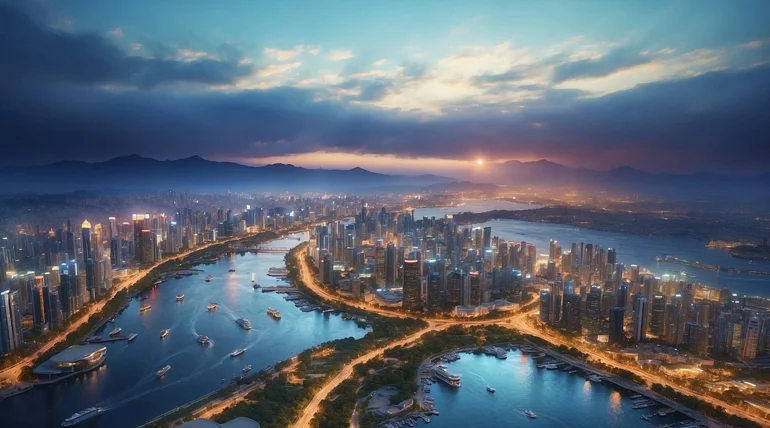
Buildings, municipalities, cities and infrastructure
- Building & Infrastructure – Sustainable architecture with natural materials and community-oriented living concepts.
- Sustainable construction: Use of hemp, wood, clay or recycled materials.
- Communal areas: kitchens, workshops and meeting halls.
- Independent supply: Heating systems (e.g. wood or biogas), recycling and waste recovery.
- Sustainable architecture with natural building materials.
- Circular economy to minimize waste.
- Living spaces that promote social interaction and community life.
- Community centers for gatherings, cultural and social activities.
- Natural energy efficiency through construction and siting.
Would you like to read more about it? Contact us!
Trust - Trade - Transaction

Economic, Bank, money and payment systems
- Economy & Finance – Local currencies, circular economy and ethical financial models for a stable economy.
- Security Rules for the Use of Asset backet digital currencies by Indogenous Communities
- 1) The Creation and Coverage of the Currency must be completely transparent and in accordance with the Communities (maybe by using digital contracts).
- 2) The business model of the provider of the infrastructure as well as the ownership must also be openly communicated and must be audited periodically.
- 3) The currency coverage must be in owndership of the local Communities.
- 4) The accounting entries for currency creation must be coordinated and regularly audited (using a mixture of automatical protocols / message systems) and competent examinations.
- 5) No kinds of „debt“ will be accepted as part of money creation or circulation.
- 6) The rules of price setting must be transparent and under the management of the Communities/local authorities that are elected and autorized by them.
- 7) It must be possible to expand the IT-system, step by step, to integrate relevant information concerning quantities and qualities of „goods and services“ down to the level of single individuals, without compromising data security and integrity of producers and consumers, making it possible for consumers to promote themselves into „prosumers“ by developing skills and the competency for beneficial cooperation.
- 8) The electronical ID-system used must be under full control of the individuals involved and follow the best security standards currently known
- Local currencies:
- Introduction of community currencies to strengthen the community (physical or digital).
- Bartering:
- Direct exchange of goods and services.
- Cryptocurrencies:
- Use for secure external transactions.
- Circular economy that minimizes resource consumption.
- Promotion of cooperatives and community entrepreneurship.
- Ethics-based financing models for social projects.
- Promotion of self-sufficiency and sustainable trade.
Would you like to read more about it? Contact us!
Transportation - Import & Export
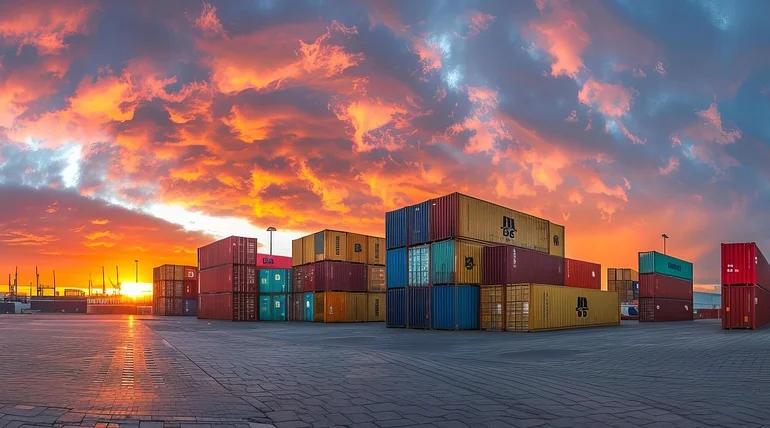
Transportation, import and export
- Transportation & Trade – Emission-free transportation and sustainable trade to promote self-sufficiency.
- Internal mobility: Bicycles, motorcycles, cars, trucks and electric vehicles for short distances powered by space energy or free energy.
- Shipping and air transportation
- External mobility: car sharing, cooperation with regional transport providers.
- Sustainable logistics: use of electric trucks for freight transportation.
- Emission-free means of transportation such as bicycles, electric and hydrogen vehicles.
- Promotion of local production to reduce imports.
- Sustainable trade structures with other communities.
- Community-based mass transit for better mobility.
- Traditional transportation methods (horses, boats) to complement modern systems.
Would you like to read more about it? Contact us!
Culture - Art - Hobby - Sport
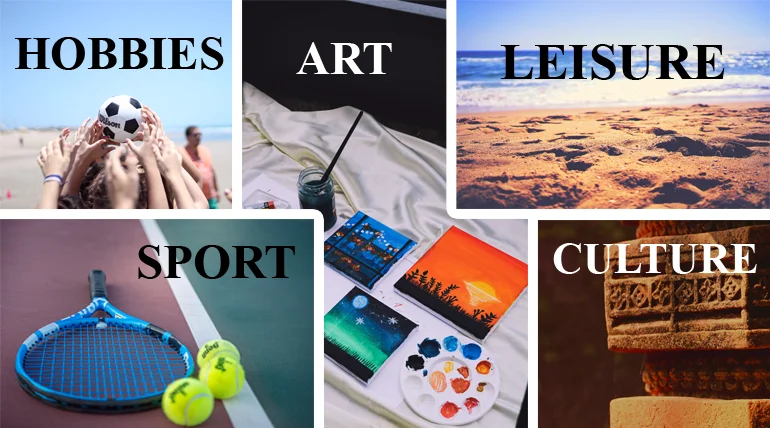
Leisure, hobbies, art, sport, culture
- Culture & Leisure – Promotion of indigenous art, music, dance and community festivals to strengthen identity.
- Cultural centers and art workshops to promote indigenous art.
- Sports and exercise programs linked to traditional practices.
- Joint festivals and events to strengthen identity.
- Promotion of traditional music, dance and storytelling.
- Nature-based recreational activities to promote a sense of community.
Would you like to read more about it? Contact us!
Media & Communication Systems
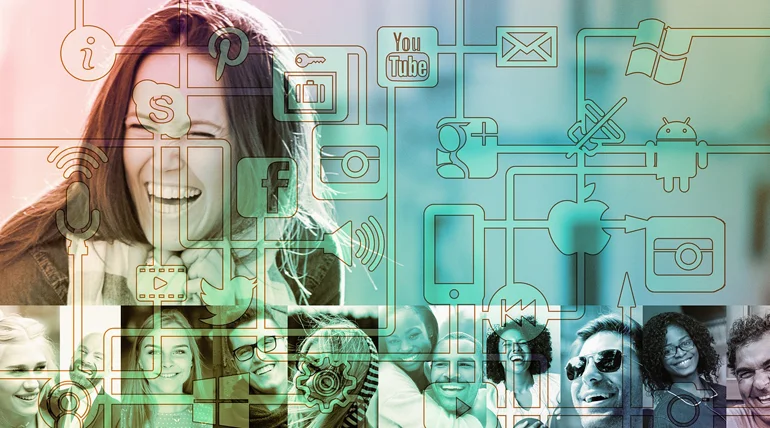
Media, social media and communication systems
- Media & Communication – Own media platforms and digital technologies to preserve indigenous languages and knowledge.
- Laptops, computers, cell phones, electronic watches, I-pads, televisions, electronic items that do not emit any pathogenic but healthy energy and guarantee absolute security for personal data.
- Software solutions that guarantee absolutely secure standards for personal data.
- Internal media: Platforms such as Nextcloud for organization, community newspaper.
- External media: website, social media, content production (videos, blogs).
- Networks: Cooperation with other communities.
- Store systems
- Own media platforms for independent reporting.
- Education via social media to strengthen the community.
- Promotion of indigenous languages and cultures through digital technologies.
- Digital libraries with indigenous knowledge and wisdom.
- Use of alternative communication systems for self-determination.
Would you like to read more about it? Contact us!
Financial planning > 500 years

Financial planning 5 - 50 - 100 - 200 years
- Long-term financial planning – Strategies for a sustainable future across generations, with a focus on social and environmental stability.
Would you like to read more about it? Contact us!
Executive summary
The self-sufficient community needs land and space for housing and agriculture. Through careful planning and cooperation, a self-sufficient life is possible.

United

Jointly
Autarkic
United Indigenious Nation
Together into the future
History and indigenous future Children of God
For thousands of years, people and their peoples have been enslaved, killed and exploited by inhuman beings and forces of God’s creation.
If you would like to know more, please contact us using the contact form. Thank you very much.
